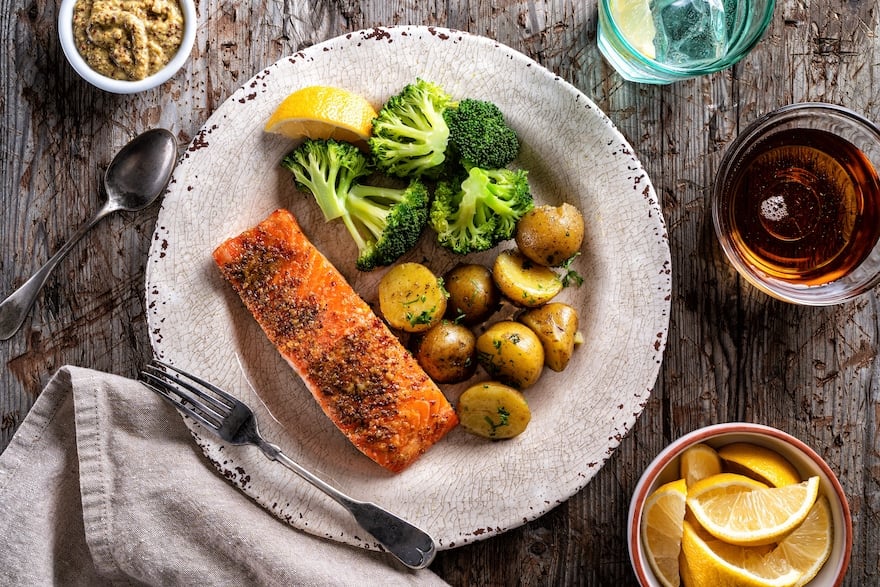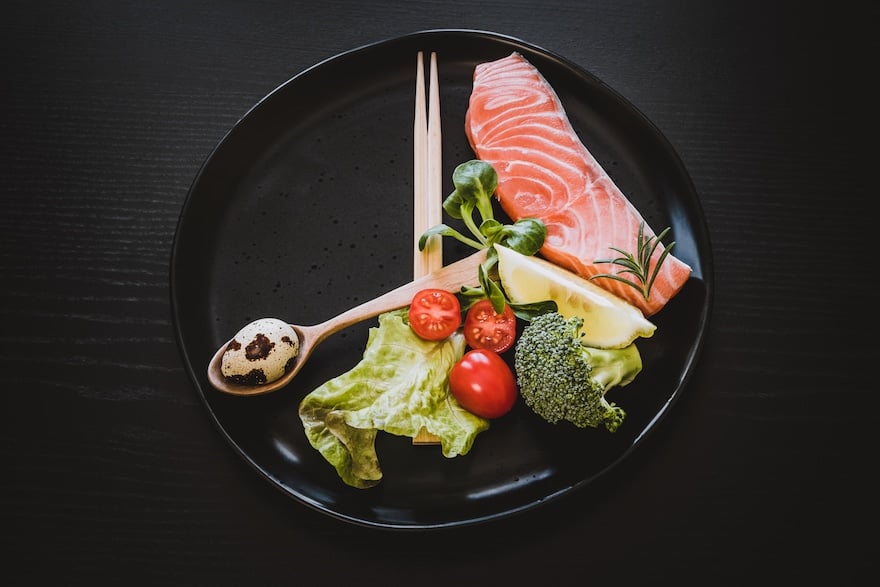The 5:2 diet is a popular form of intermittent fasting. Learn more about if the 5:2 diet is healthy—and who should (and shouldn’t) consider trying it.
While it might sound like a trendy new diet, the 5:2 diet is a form of intermittent fasting (IF). It’s been increasing in popularity because many people have found it easier to implement than other, more restrictive versions.
Chances are you have at least one friend or co-worker who won’t stop talking about intermittent fasting. Celebrities like Jennifer Aniston and Chris Pratt swear by it, and countless social media wellness influencers promote it. Plus, there’s solid science to back it up. But should you try the 5:2 diet?
We spoke to dietitians and dove into the research about this popular form of intermittent fasting to get the real skinny.
What Is the 5:2 Diet?
The 5:2 diet is a cross between a diet that restricts calories and an intermittent fasting diet. “Intermittent fasting is going without food for certain periods of time,” says explains Elizabeth Ward, MS, RDN, a registered dietitian nutritionist in Reading, Massachusetts and the co-author of The Menopause Diet Plan, A Natural Guide to Hormones, Health, and Happiness.
On the 5:2 diet, you eat normally five days a week and restrict your calories to 500 to 600 calories on two non-consecutive days per week (such as Monday and Thursday).
The 5:2 diet is also known as The FastDiet (which has a companion book by British journalist Michael Mosley). Research proves that it might be easier to follow than a typical calorie-restricted diet for those trying to lose weight since it only requires tracking calories for two days each week instead of seven.
How Does the 5:2 Diet Compare to Other Types of Intermittent Fasting?

The 5:2 diet isn’t the only type of intermittent fasting. In fact, there’s no one standard definition of intermittent fasting. The goal behind all forms of IF is to take advantage of changes in the body’s metabolism (meaning how it breaks down food and turns it into energy) during times of feasting and times of fasting.
Kristin Kirkpatrick, RDN, MS, a Denver, Colorado-based registered dietitian, says other common forms of IF include:
- Time-Restricted Intermittent Fasting
This often comes in the form of 16:8 or 14:10. Eat normally for eight or 10 hours (for example, 10 a.m. to 8 p.m.), then fast for the following 16 or 14 hours.
- Alternate-Day Intermittent Fasting
Eat normally for 24 hours, then fast (often 500 to 600 calories for the day) for the following 24 hours.
- The Warrior Diet:
Fast for 20 hours each day followed by one large meal at night.
What Can You Eat On the 5:2 Diet?
Aside from limiting the number of calories you eat two days a week, the 5:2 diet doesn’t include guidance on what you should eat. While that may sound like a perk, it sounds an alarm for Ward.
“It’s really easy for the 5:2 diet to become an eating free-for-all,” Ward says.
On the days when 5:2 dieters eat normally, Ward warns that it’s important to include enough carbohydrate, protein, fat, and fiber so that your body gets the nutrients it needs. But even then, it’s questionable that you will get all that you need for the entire week in five days of eating.
Kirkpatrick has several clients who enjoy IF for its structure and flexibility compared to time-restricted eating. “Many of my clients prefer the 5:2 diet since they cannot commit to stop eating every single evening around 6 or 7 p.m., for example,” she says. This way, they can still take part in work dinners (or family dinners after working late). But anyone—regardless of lifestyle—needs to still focus on the quality of foods, not just the quantity of time they’re able to eat them.
Generally, Kirkpatrick advises them to aim for a low- to moderate-carbohydrate diet with a focus on highly nutrient-dense foods on days they are and aren’t fasting.
On fasting days, 5:2 dieters often eat three small meals or two slightly larger ones. But their total daily calorie quota must remain below 500 for women and 600 for men. High-fiber, high-protein, and low-calorie foods are the best bet to limit hunger. A few popular 5:2 diet foods include:
- Steamed, raw, roasted, or riced vegetables
- Fresh or frozen fruit
- Unsweetened Greek yogurt
- Cottage cheese
- Eggs
- Grilled, steamed, or baked fish
- Grilled or baked lean meat
- Broth-based soups
An example of a two-meal-per-day menu that clocks in at just above the female 500-calorie tally would be:
- Meal one: 1 5.3-ounce container of plain Greek yogurt with 1 cup berries and ½ ounce walnuts
- Meal two: 1 cup steamed Brussel sprouts with 1 egg and ½ cup cooked quinoa
You can drink coffee, tea, lemon water, and regular water as desired throughout all hours of the day since they contain zero calories (or very close to it).
5:2 Diet Results to Expect

Before you embark on your own intermittent fasting adventure by following the 5:2 diet, consider these science-backed details about the lifestyle.
- You might see a shift on the scale. The average IF dieter lost up to eight percent of their total body weight in three to 12 weeks during one study. This is likely due to a boost in metabolic rate. Another study found that IF has the potential to increase metabolism by up to 14 percent.
- You’re not guaranteed to lose weight. Calories in, calories out rings true: Followers of the 5:2 diet don’t lose any more weight than those on a regular calorie-controlled diet if they eat the same amount of energy.
- You may maintain more muscle mass. One benefit of the 5:2 diet is muscle maintenaince. IF leads to a much smaller reduction in muscle mass than traditional calorie-restricted diets, according to a research review.
- Intermittent fasting can improve insulin sensitivity. Insulin levels tend to be lower among those who fast, which can assist the body in accessing stored energy—and in turn, potentially lead to weight loss. Lower insulin resistance is related to reduced risk for type 2 diabetes as well.
- The 5:2 diet might slow the aging process. Since cells are able to enter “autophagy” during fasting, they might be more efficient at eliminating damaged cell parts and protein build-up floating around the body.
- You may experience less chronic inflammation. Some studies point to lower levels of oxidative stress among those who practice IF. (This form of stress occurs internally when the antioxidant and free radical balance is out of whack. If persistent, oxidative stress can trigger several chronic diseases, including type 2 diabetes, heart disease, and certain cancers.)
- Your cortisol levels might rise. Counting calories, even just for a couple of days per week, can feel limiting enough to hike the production of a stress-related hormone called cortisol. Extra cortisol can lead to 5:2 dieters experiencing cravings, weight regain (especially around the midsection), and feelings of deprivation.
- Socializing can be challenging. Despite all of the benefits of the 5:2 diet, this is one major drawback to be aware of. On days when you’re fasting, it’s nearly impossible to socialize at a restaurant, happy hour, potluck, or work lunch unless you can find a meal with 500 calories or less.
The Takeaway
There are pros and cons to the 5:2 diet.
Talk to your doctor and a dietitian before embarking on any IF plan, including the 5:2 diet, and steer clear if you are currently diagnosed with or have a history with:
- Eating disorders
- Being underweight
- Chronic diseases, including type 1 and type 2 diabetes, kidney disease, high blood pressure, or heart disease
Pregnant and breastfeeding women, endurance athletes, and anyone under age 18 and over 75 should also avoid severely restricting calories, Ward adds.
“If you choose to follow this plan, eat a balanced diet on the days when you eat normally and take a multivitamin every day to cover micronutrient gaps on the days when you undereat.” Ward says “Even then, you risk nutrient deficiencies.” So make sure to consult with a nutrition professional to design a meal plan that will cover all of your body’s needs.









